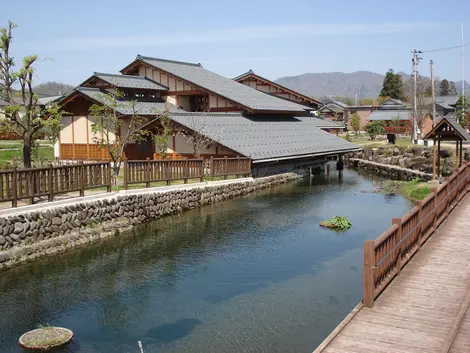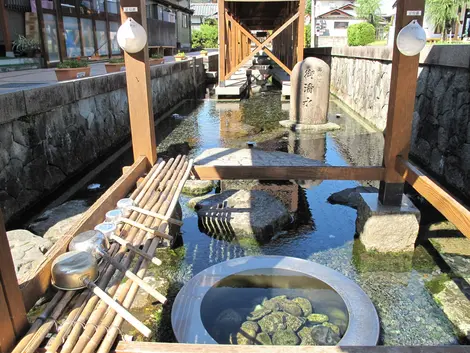Ono, city of water 大野市
well of harmony
City of the former province of Echizen in the prefecture of Fukui, Ono has built its history and its culture around the abundant natural resources from which it benefits, and in particular its groundwater.

Karikomi Pond
City of Ono
Valorization of aquatic resources
The charming city of Ono was built by Kanamori Nagachika in 1576 on the model of Kyoto , which earned it the nickname "little Kyoto of Hokuriku" . As if lost in the middle of the mountains, it was at that time a strategic point on the Minokaido road which linked the provinces of Echizen and Mino.
See: Echizen, cradle of washi paper
The inhabitants of Ono will be happy to welcome you to this small town steeped in history, surrounded by attractive mountains and which has been able to exploit the benefits of its exceptional water reserve to continue to prosper. The city of Echizen-Ono is indeed characterized by its abundant water table and it is no coincidence that it was decided to build, more than 4 centuries ago, the capital of Lord Kanamori Nagachika in this humid plain. where many natural springs gush forth. The city center was designed from its construction in the 16th century with a complete water supply and drainage system. This network of wells and drainage canals is still used by the inhabitants for their daily needs and its distribution rate of return remains at 20%. Most households consume water coming directly from the groundwater to the point that free water is obvious to locals . 70% of households have their own well (ie 8,163 private wells) and even today, it is common to drill a well when building a new house, which is unique in Japan. Water is therefore an essential element, which is part of the daily life of the inhabitants and which has played a crucial role in the history and culture of the city, in sectors such as agriculture, gastronomy, industry and urban planning. .
Pure Springs
During your walk, you can take advantage of many springs fed by the surrounding mountains to refresh and hydrate you. With a bit of luck, you'll spot sticklebacks swimming in the clear, clear water of Hongan Spring near Lord Asakura Yoshikage's tomb, and maybe even in the Shinbori River south of Kameyama Hill. . This small three-spined freshwater fish, particularly loved by locals, is a protected species in the city. You can also observe them and learn more about them at the stickleback village near the source of the Hongan.
- The O-Shozu Spring
It is the most famous spring in the city of Ono and many Japanese people come from afar to be able to recharge their batteries there. It is in the Izumi-chō district, just east of Kameyama Hill and not far from the streets lined with residences of Edo period warriors. Its water was originally used to wash the rice from the meals of the ruler of the city, so it was respectfully named "Pure Water" O-Shozu or "Pure Water of the Lord" Tono-sama Shozu .
The samurai of the time used it with strict discipline : it was always necessary to keep it clean and to draw water for consumption upstream in order, to refresh the fruits in a specific place, to wash the vegetables in another. .. It's also the perfect place to meet neighbors and hold conversations. A foot bath in the O-Shozu spring will be perfect for cooling you down in summer and warming you up in winter. The O-Shozu spring has been listed since 1985 on the list of 100 famous waters of Japan by the Japanese Ministry of the Environment.
Useful information :
Address: 5-4 Izumicho, Ono-shi, Fukui-ken 912-0086
Telephone: +81 (0)779-66-1111
- The source of the Hongan
Kanamori Nagachika developed an irrigation canal shortly after his domination of the plain to bring water to the city center from a particularly abundant source, located to the south of the agglomeration. Some say it is called Hongan because there was once a Hongan-ji branch temple at the edge of the spring . Hongan water has long been used for daily needs and against fires . The spring is also included in the list of the 100 famous waters of Japan .
In 1934, it was also recognized as a biological heritage of national significance for being the southernmost stickleback habitat in Japan. The local authorities are promoting these small freshwater fish as a heritage species of the city by building in 2001 the museum of the "little village of sticklebacks" right next to the source. The purpose of the establishment is to preserve and transmit to the youngest the importance of the aquatic resources of the city of Ono. It includes an aquarium, an exhibition on water in popular culture and offers educational workshops for children.
It is not uncommon to see a few children having fun fishing for crayfish in the park's pond. Of American origin, these crayfish threaten to destroy the local ecosystem by feeding on stickleback eggs and their fishing is strongly encouraged by the authorities.
Useful information :
Address: 8-44 Itoyocho, Ono-shi, Fukui-ken 912-0054
Telephone: +81 (0)779-65-5104
Opening hours: closed on Mondays and public holidays
Prices: adult 200 yen, child 50 yen
Read: The 5 most beautiful aquariums in Japan
Holy water
At the end of a majestic alley of cypresses, the Shinokura sanctuary, founded in 717 , is worth a detour for the many springs it houses. It celebrates the deity Okuninushi no mikoto, a central figure in Japanese mythology . Legend has it that Okuninushi no mikoto caused the holy spring to spring from Benten Pond, which is located just behind the prayer pavilion. The water from this spring is particularly known for curing eye diseases , so much so that it is nicknamed "Shinokura Eye Remedy" and people come from far and wide to drink it.

Spring of Shinokura Shrine
City of Ono
In the Heian period, a small shrine dedicated to Benzaiten, the goddess who in Japanese folk Buddhism prodigies wealth, was moved right to the edge of the pond. During the drought of the Edo period, villagers from the northern hamlets of the city would travel to the shrine to pray while performing the Rain Dance .
To go further: 5 famous Japanese legends
For the more curious among you, the Shinokura sanctuary offers its visitors 3-hour guided tours with an introduction to the Shinto religion (votive tablets, amulets...), the possibility of attending a ceremony wearing the traditions of Shinto priests (kannushi) and priestesses ( miko ).
Useful information :
Address: 42-5 Shinokura, Ono-shi, Fukui-ken 912-0061
Telephone: +31 (0)779-66-1111
Prices: free visit, interactive lessons on Shinto 1,500 yen (12€), rental of religious clothing 4,500 yen (35€), reservation by email at least 3 days before (cafe.namecameono@gmail.com)
Water in the food industry
Among the region's best-known specialties are rice, taro, and maitake mushroom. But the city has several old shops specializing in fermented foods such as soy sauce , miso , sake or vinegar that bear witness to a long culture of brewing and fermentation techniques in Ono.
Four different kinds of sake are produced in the Ono region. Hanagaki, a sweet sake produced by the Nanbu brewery, is undoubtedly the best known of the four, it is even beginning to be exported abroad. It is possible to visit the four breweries: Nanbu, Uno, Manazuru and Genpei as well as to do tastings. For anyone interested in this Japanese beverage, this is an opportunity to chat directly with brewers and learn more about its manufacturing processes.
Read: Sake
The Nomura Soy Sauce Shop, founded during the Meiji era, is the oldest specialized store in Ono's fermented products. He still makes fermented soybean pastes as well as 100% naturally fermented soy sauces using the delicious spring water from the city of Ono .
In addition to a tour and tasting of the different types of sauces, the Nomura shop offers its visitors the opportunity to make their own soy sauce , from mixing the ingredients to bottling, including the pressing and filtering stages. . You can also personalize your bottle with drawings. Don't miss the opportunity to discover one of Japan's most ancient fermentation techniques through this one-of-a-kind experience.
Useful information :
Address: 野村醤油 Nomura Shôyu, 10-1, Hiyoshi-chô, Ono.
Telephone: +81 (0)779-66-2072
Hours: 8 a.m. to 7 p.m., closed at New Year's
Website
Prices: to make 150 ml of soy sauce, 1,000 yen (€8) per person, duration 1 hour, from 6 years old, group of 2 to 15 people. Reservation two days in advance.
To visit: Ono Castle
































